<< Previous | Displaying results 2651-2700 of 6769 for "" | Next >>
German civilians from Volary attend burial services for the Jewish women exhumed from a mass grave in the town. The victims died at the end of a death march from Helmbrechts, a subcamp of Flossenbürg. Germans were forced to exhume them in order to give the victims proper burial. Volary, Czechoslovakia, May 11, 1945.
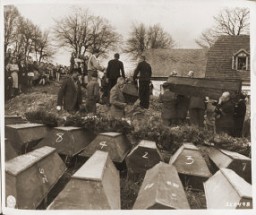
A US soldier stands among the corpses of prisoners exhumed from a mass grave in a ravine near Nammering. On April 19, 1945, a freight train with nearly 4,500 prisoners from Buchenwald pulled onto the railroad siding at Nammering. Hundreds of prisoners who had died on the train were buried in the mass grave along with the prisoners who were forced to carry the corpses to the ravine and were then shot. Germany, ca. May 6, 1945.

Destruction of the Dortmund synagogue during Kristallnacht (the "Night of Broken Glass"). Germany, November 1938.
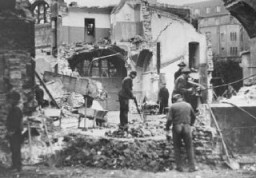
The last remaining wall of the Boerneplatz synagogue, destroyed during the Kristallnacht ("Night of Broken Glass") pogrom. Onlookers watch during the dismantling and removal of remnants of the synagogue. Frankfurt am Main, Germany, January, 1939.
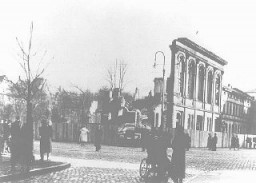
A private Jewish home vandalized during Kristallnacht (the "Night of Broken Glass" pogrom). Vienna, Austria, November 10, 1938.
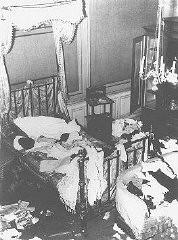
A private Jewish home vandalized during Kristallnacht (the "Night of Broken Glass" pogrom). Vienna, Austria, November 10, 1938.
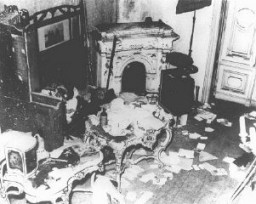
SS guards force Jews, arrested during Kristallnacht (the "Night of Broken Glass"), to march through the town of Baden-Baden. Onlookers watch from along the street and walls. Baden-Baden, Germany. November 10, 1938.
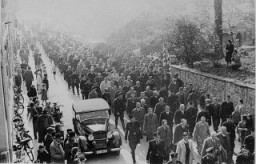
After the Kristallnacht pogrom, German civilians line the streets to watch the forced march of Jewish men through the town. Baden-Baden, Germany, November 10, 1938.
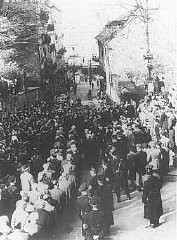
View of the old synagogue in Aachen after its destruction on Kristallnacht. Aachen, Germany, photo taken ca. November 10, 1938.
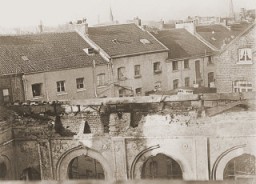
View of the old synagogue in Aachen after its destruction on Kristallnacht. Aachen, Germany, photo taken ca. November 10, 1938.
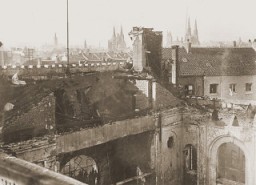
The damaged lintel above a Torah ark from a synagogue that was destroyed during Kristallnacht. Nentershausen, Germany, 1938.
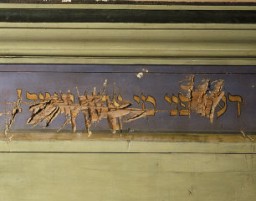
Shattered storefront of a Jewish-owned shop destroyed during Kristallnacht (the "Night of Broken Glass"). Berlin, Germany, November 10, 1938.
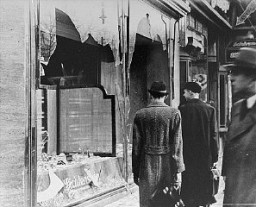
German children read an anti-Jewish propaganda book for children titled Der Giftpilz (The Poisonous Mushroom). The girl on the left holds a companion volume, the translated title of which is "Trust No Fox." Germany, ca. 1938. (Source record ID: E39 Nr .2381/5)
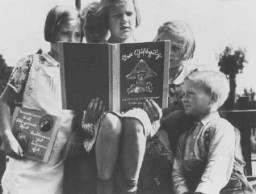
German propaganda photograph of a kindergarten for German infants promotes the nurturing role of women on the home front. Germany, 1941.
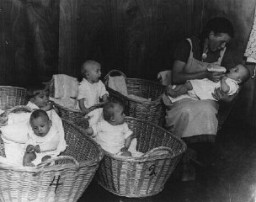
Nazi propaganda poster warning Germans about the dangers of east European "subhumans." Germany, date uncertain.
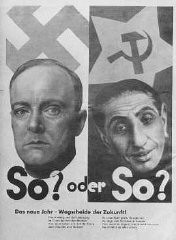
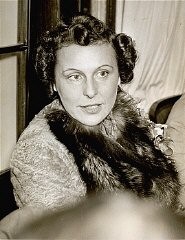
Hitler reviews a parade celebrating the reintegration of the Saar region into Germany. Saar territory, Germany, March 1935.
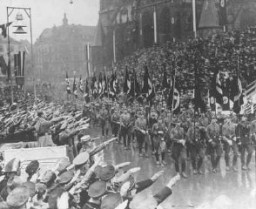
Hitler during a triumphal tour of the Sudetenland following the Munich agreement of September 1938. The agreement ceded the largely German-speaking Sudeten region of Czechoslovakia to Germany. Eger, Czechoslovakia, October 3, 1938.
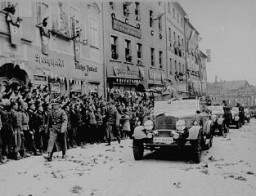
German troops marching into the Sudetenland stop at a former Czech frontier post. Nazi officials and Sudeten Germans salute the troops. The sign between the swastikas reads: "One People, One Reich, One Führer." Grottau, Czechoslovakia, October 2 or 3, 1938.
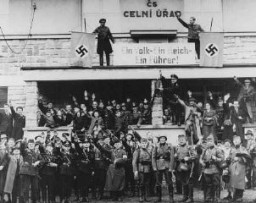
Adolf Hitler, the newly appointed chancellor, greets German president Paul von Hindenburg. Berlin, Germany, January 30, 1933.
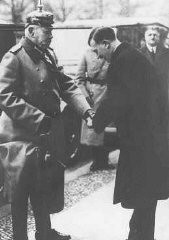
Adolf Hitler, Wilhelm Frick, and Hermann Göring wave to a torchlight parade in honor of Hitler's appointment as chancellor. Behind Göring stands Rudolf Hess. Berlin, Germany, January 30, 1933.

On the day of his appointment as German chancellor, Adolf Hitler greets a crowd of enthusiastic Germans from a window in the Chancellery building. Berlin, Germany, January 30, 1933.
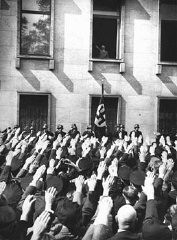
Adolf Hitler (hand on rail) with Hermann Göring (second to left of Hitler) and Joseph Goebbels (third to left of Hitler) at the site of the fire that damaged the Reichstag (German parliament) building. Berlin, Germany, February 1933.
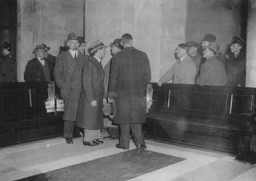
Dome of the Reichstag (German parliament) building, damaged by fire on February 27, 1933. Hitler used the arson to convince President Hindenburg to declare a state of emergency, suspending constitutional safeguards. Berlin, Germany, 1933.
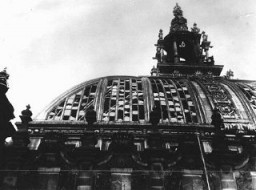
Joseph Goebbels (standing) testifies for the state during the Reichstag Fire Trial before the Supreme Court. Leipzig Germany, 1933.
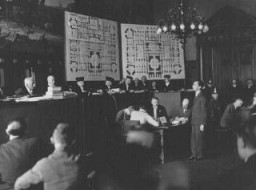
Battalions of Nazi street fighters salute Adolf Hitler during an SA parade through Dortmund. Germany, 1933.
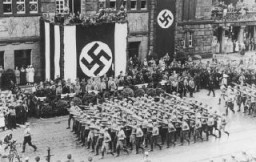
Arrival of political prisoners at the Oranienburg concentration camp. Oranienburg, Germany, 1933.
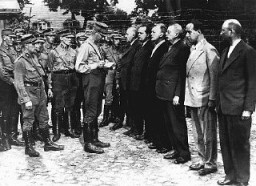
Social Democratic political prisoners in the Duerrgoy concentration camp near Breslau. Seated in the center is Paul Loebe, a leading Socialist and former president of the German parliament. Duerrgoy camp, Germany, August 4, 1933.
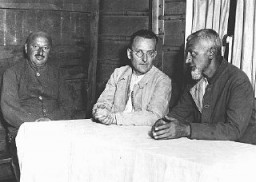
Many of the early concentration camps were improvised. Here, roll call is held for political prisoners aboard a ship used as a floating concentration camp. Ochstumsand camp, near Bremen, Germany, 1933 or 1934.
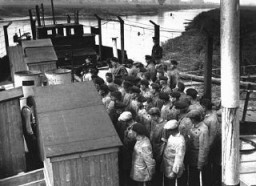
The cover of a Nazi publication on race, Neues Volk (New People), portrays motherhood with this ideal image of an "Aryan" mother and child. Germany, September 1937.

Women were included in preparations for national defense even before the war. Here, some German women form a unit of the civilian Air Defense League. Germany, November 15, 1936.
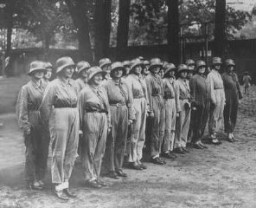
Members of the Nazi girls' organization, the League of German Girls (BDM), do a group exercise. Dresden, Germany, December 1936.
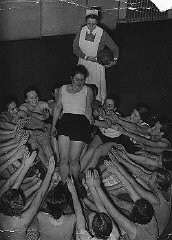
Nazi policy encouraged racially "acceptable" couples to have as many children as possible. Because of the number of children in this Nazi Party official's family, the mother earned the "Mother's Cross." Germany, date uncertain.
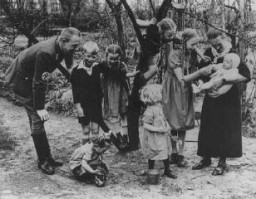
A parade of young Austrian women, members of the Nazi youth organization the League of German Girls (Bund Deutscher Maedel). Graz, Austria, February 20, 1938. The Hitler Youth and the League of German Girls were the primary tools that the Nazis used to shape the beliefs, thinking and actions of German youth.
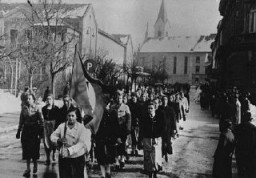
A work corps of German women marches to the fields. Beginning in 1939, many thousands of German women between the ages of 17 and 25 worked on farms as part of a national labor service program. Germany, wartime.
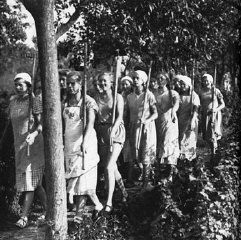
Catholic clergy and Nazi officials, including Joseph Goebbels (far right) and Wilhelm Frick (second from right), give the Nazi salute. Germany, date uncertain.
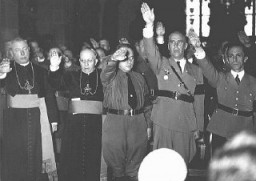
Martin Niemöller, a German theologian and pastor, on a visit to the United States after the war. A leader of the anti-Nazi Confessing Church, he spent the last seven years of Nazi rule in concentration camps. United States, October 4, 1946.
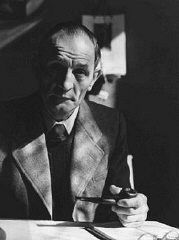
Dietrich Bonhoeffer, German Protestant theologian who was executed in the Flossenbürg concentration camp on April 9, 1945. Germany, date uncertain.
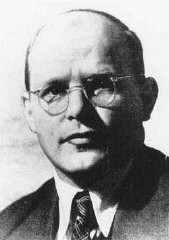
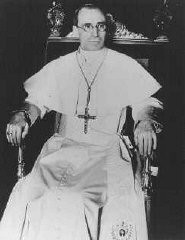
In the auditorium of the Propaganda Ministry and Public Enlightenment, Nazi Propaganda Minister Joseph Goebbels delivers a speech to his deputies for the press and arts. Berlin, Germany, November 1936.
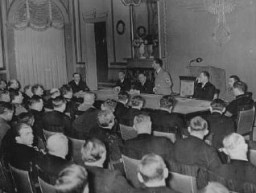
Germans crowd around a truck filled with "un-German" books, confiscated from the library of the Institute for Sexual Science, for burning by the Nazis. The books were publically burned at Berlin's Opernplatz (Opera Square). Berlin, Germany, May 10, 1933.
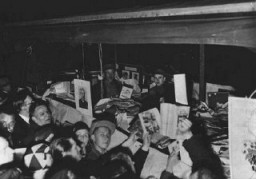
Across Germany, students took books by truck, furniture van, even oxcart, and heaped them into pyres on public squares. This image shows members of the SA and students from the University of Frankfurt with oxen pulling manure carts loaded with books deemed "un-German." Frankfurt am Main, Germany, May 10, 1933.
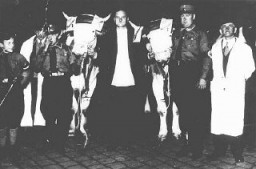
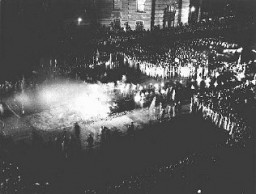
Public burning of "un-German" books in the Opernplatz (Opera Square). Berlin, Germany, May 10, 1933.
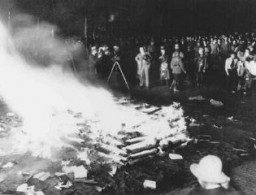
At Berlin's Opernplatz, crowds of German students and members of the SA gather for the burning of books deemed "un-German." Berlin, Germany, May 10, 1933.
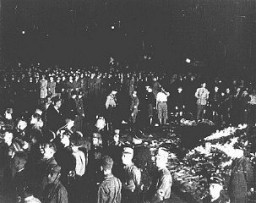
Russian-born Jewish artist Marc Chagall with his daughter, Ida. The Nazis declared Chagall's work "degenerate." After the fall of France, where he had been living, Chagall fled to the United States. United States, 1942.
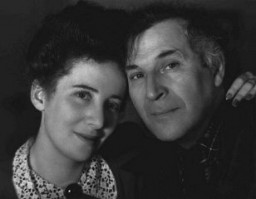
Georg Grosz, a Communist satirical artist and painter, seen here in his studio in Berlin. He fled Germany shortly before the Nazi rise to power in 1933 and was one of the first to be stripped of his German citizenship by the Nazis. Berlin, Germany, 1929.
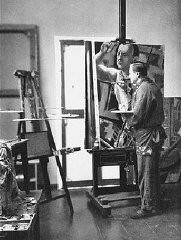
Display from "Der ewige Jude" (The Eternal Jew), a Nazi antisemitic exhibit which claimed that Jews heavily dominated the German performing arts. A phrase at the top of the display states "Shameless Entertainment." Berlin, Germany, November 11, 1938.
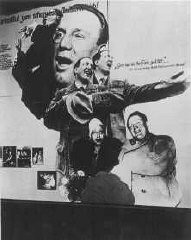
Xaver Franz Stuetzinger, a member of the Communist Party of Germany, was tortured by the SS at the Dachau concentration camp. He died in May 1935 without divulging his connections. Germany, before May 1935.
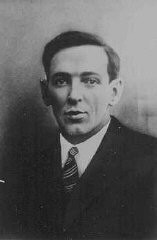
Ernst Thaelmann, leader of the German Communist Party, was detained during a mass arrest of Communists following the fire that virtually destroyed the Reichstag (German parliament) building. Germany, date uncertain.
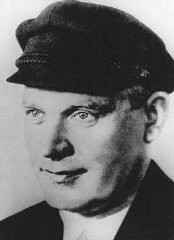
We would like to thank Crown Family Philanthropies, Abe and Ida Cooper Foundation, the Claims Conference, EVZ, and BMF for supporting the ongoing work to create content and resources for the Holocaust Encyclopedia. View the list of donor acknowledgement.